Drum brake adjustment
Discussion
So took my CZ for it's first ever MOT today after the rebuild.
It failed on both front and rear brakes being inefficient.
I have no problem rebuilding combined ABS units but I'm not so sure on drums. I fitted new shoes to both drums and a new cable on the front.
I'll admit I was concerned about adjusting them too much and causing binding so they are relatively loose. The front lever almost comes back to the bar.
What am I looking for here? Should this just be the adjuster isn't tight enough on them? The TLS front had it's levers adjusted off of the wheel to check that it was operating both arms evenly.
The tester refused to work on the bike so he's out.
It failed on both front and rear brakes being inefficient.
I have no problem rebuilding combined ABS units but I'm not so sure on drums. I fitted new shoes to both drums and a new cable on the front.
I'll admit I was concerned about adjusting them too much and causing binding so they are relatively loose. The front lever almost comes back to the bar.
What am I looking for here? Should this just be the adjuster isn't tight enough on them? The TLS front had it's levers adjusted off of the wheel to check that it was operating both arms evenly.
The tester refused to work on the bike so he's out.
I normally just spin the wheel and adjust the brake until it just starts to bind and thenback it off slightly so there is no resistance.
It's probably worth checking everything is free movement wise and free from grease. I don't suppose they will have much power if they are just cable operated. My tester said to pass the mot, the bike has to be able to lock the wheel on the roller, so it might be worth checking your tyre pressures too.
It's probably worth checking everything is free movement wise and free from grease. I don't suppose they will have much power if they are just cable operated. My tester said to pass the mot, the bike has to be able to lock the wheel on the roller, so it might be worth checking your tyre pressures too.
xstian said:
I normally just spin the wheel and adjust the brake until it just starts to bind and thenback it off slightly so there is no resistance.
It's probably worth checking everything is free movement wise and free from grease. I don't suppose they will have much power if they are just cable operated. My tester said to pass the mot, the bike has to be able to lock the wheel on the roller, so it might be worth checking your tyre pressures too.
Thanks, yeah that sounds like a good idea actually. Shall give it a go. Ahhhh that's interesting.It's probably worth checking everything is free movement wise and free from grease. I don't suppose they will have much power if they are just cable operated. My tester said to pass the mot, the bike has to be able to lock the wheel on the roller, so it might be worth checking your tyre pressures too.
xstian said:
ThreadKiller said:
My dt175 had cable operated drum brake and its woeful. Don’t know if they get stretchy/elastic, but I changed the cable and that helped a bit. Most braking has to be done with the rear.
What was wrong with the front brake? One of the bike mags back last century published a list of the most extreme things they'd noted in bikes they'd reviewed.
ISTR, there was a best stopping distance from 30mph of about 23ft and a worst of about 230ft.
The worst being a certain bike from the Eastern Bloc as it was back then.
I did some miles on Eastern Bloc bikes when I was a student.
The brakes were poor, but could often be improved by:
Ensuring there was not much friction in the cables.
Using quality cables which don't stretch or compress
Checking the linings were not oily
Checking the cams moved freely
Getting the shoes re-lined with better material
Really you just need to go through it from end to end and work out why force on the lever doesn't translate into pressure at the friction material.
The 'posh' answer was a twin leading shoe front brake from a Honda.
One subtlety to be aware of is that with drum brakes, the forks going out of true during braking often messes things up, so a chunky old mudguard which acts as a fork brace often helped, and removing it in favour of a stylish ali blade did not help!
ISTR, there was a best stopping distance from 30mph of about 23ft and a worst of about 230ft.
The worst being a certain bike from the Eastern Bloc as it was back then.
I did some miles on Eastern Bloc bikes when I was a student.
The brakes were poor, but could often be improved by:
Ensuring there was not much friction in the cables.
Using quality cables which don't stretch or compress
Checking the linings were not oily
Checking the cams moved freely
Getting the shoes re-lined with better material
Really you just need to go through it from end to end and work out why force on the lever doesn't translate into pressure at the friction material.
The 'posh' answer was a twin leading shoe front brake from a Honda.
One subtlety to be aware of is that with drum brakes, the forks going out of true during braking often messes things up, so a chunky old mudguard which acts as a fork brace often helped, and removing it in favour of a stylish ali blade did not help!
I don't have a pic' to back this up, but a quick Google should explain what I mean. Be careful of the angle of the brake arm, the one at the brakeplate at the wheel. When the brake is fully on, the angle between the arm and the cable should be around 90 degrees. If the angle is more than 90, the arm may be set up wrongly at the brake cam - particularly if it's on splines.
That said, the brakes on these were infamous for being rubbish when new and, as said above, a change of front wheel was a common mod' among the despatch riders I knew. I'd imagine a longer brake arm could be an "easy" improvement.
That said, the brakes on these were infamous for being rubbish when new and, as said above, a change of front wheel was a common mod' among the despatch riders I knew. I'd imagine a longer brake arm could be an "easy" improvement.
What Spoodler said, and another thing to look for
If the brake arm on the brake plate is clamped on a splined brake cam end,
check for any dots, marks or punch marks on this axle, and a corresponding "arrow" on the brake arm*
If the bike is old and has passed through many owners,
chances are that a skint owner turned the arm on the brake cam to get more life out of the shoes,
by spreading the shoes more after his "repair/upgrade"
This gives more "spread" but is dangerous because the cam inside the drum might "turn over",
resulting in no brake even though lever is pulled.
The mark on the cam should match the mark on the arm, or (depending on manufacturer)
the mark on the cam should be where the "clamping gap" is on the arm.
Look for pic in manual, or web.
Saw this kind of bad spannering on various old Honda Dax, Monkey, Cub etc.
If the brake arm on the brake plate is clamped on a splined brake cam end,
check for any dots, marks or punch marks on this axle, and a corresponding "arrow" on the brake arm*
If the bike is old and has passed through many owners,
chances are that a skint owner turned the arm on the brake cam to get more life out of the shoes,
by spreading the shoes more after his "repair/upgrade"
This gives more "spread" but is dangerous because the cam inside the drum might "turn over",
resulting in no brake even though lever is pulled.
The mark on the cam should match the mark on the arm, or (depending on manufacturer)
the mark on the cam should be where the "clamping gap" is on the arm.
Look for pic in manual, or web.
- this mark could be on the inside, facing the drum, after the arm was removed from the cam,
Saw this kind of bad spannering on various old Honda Dax, Monkey, Cub etc.
Also, centralise everything by slackening off the spindle nut, then holding the brake on hard while re-tightening the spindle.
Could try this (wear a mask):
http://www.stotfoldengineers.co.uk/stotfold-engine...
What you will need to do is to chalk the linings and gently apply the brakes and remove them and check the contact area. If you find some high points they can be rubbed down with 180 grit and you will have to go through the rigamarole again until you achieve full contact between the shoes and the drum.
Could try this (wear a mask):
http://www.stotfoldengineers.co.uk/stotfold-engine...
What you will need to do is to chalk the linings and gently apply the brakes and remove them and check the contact area. If you find some high points they can be rubbed down with 180 grit and you will have to go through the rigamarole again until you achieve full contact between the shoes and the drum.
Biker9090 said:
Got the bike delivered back today. Took a few pictures before I needed to get back to work. The delivery guy was more helpful than the bloody mechanic! Suggested removing any glaze from the shoes etc.
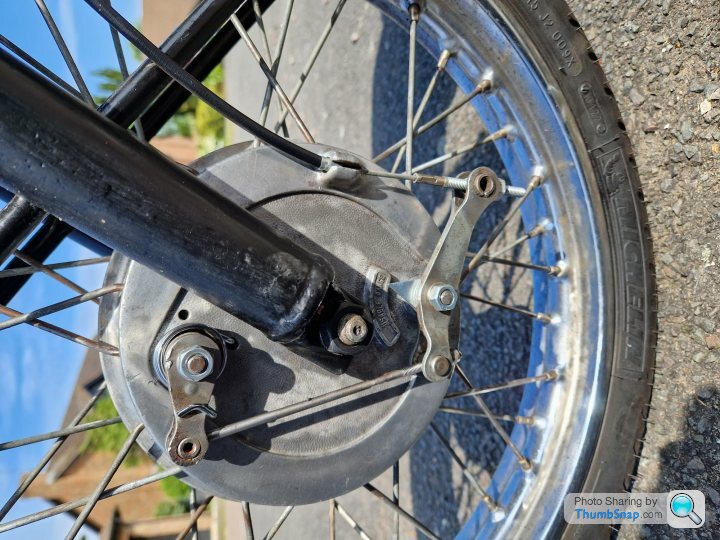
That should work reasonably well it's a twin-leading-shoe brake.
For the younger members, a leading drum brake shoe is one where the actuator (cam or cylinder) is at the leading end, so the braking force helps push the shoe harder into contact with the drum.
Firstly I would check someone hasn't put the whole thing in the wrong way making a trailing shoe brake, which would be handy for hill starts and not much else. I realise the pic is rotated, but it still looks odd? ?
Then have it apart, check the cam spindles are moving nicely in the back plate, the shoes actually move etc, everything is assembled right.
Anything could have happened over the years, put together wrong, wrong springs, whatever.
I've had old bikes which didn't work properly because various parts just did not belong together.
Checking lining contact on the drum is a good call.
As it's a TLS brake you can unlink the cams and see if one or other works better and adjust so they work together.
But, be aware that a lot of small bikes were built with terrible front brakes presumably because they didn't want riders to grab a lot of front brake and skid on awful eastern bloc tarmac or something? It may not be a coincidence Jawa riders were a bit handy at Speedway?
IS the problem you run out of lever travel or can you apply a lot of force on the lever but don't get the braking force?
Thanks for the upload, this setup is the best drum brake from engineering view,
a "single Duplex" as it is known in Germany,
only bettered by a "double Duplex" which has two brake drums, left and right, in one front hub.
A click on the pic and then another one turns the photo into the right direction,
and enlarges it to make the "usable range" indicator readable.
Seems the brake arms only fit the cams in one position,
from what I see the movement might not be in perfect synchronicity,
this even movement can be achieved by adjusting the rod between cam 1 and cam2.
Can you get someone to make a photo when the brake is fully pulled ?
Glazing shoes could be a problem, or-if they have been renewed-
shoes not properly worn in into the grooves of the drum.
If there are too many grooves in the drum, you could try getting it machined smooth,
but watch out for a "maximum diameter XXXmm" number cast inside ( or in a manual ).
a "single Duplex" as it is known in Germany,
only bettered by a "double Duplex" which has two brake drums, left and right, in one front hub.
A click on the pic and then another one turns the photo into the right direction,
and enlarges it to make the "usable range" indicator readable.
Seems the brake arms only fit the cams in one position,
from what I see the movement might not be in perfect synchronicity,
this even movement can be achieved by adjusting the rod between cam 1 and cam2.
Can you get someone to make a photo when the brake is fully pulled ?
Glazing shoes could be a problem, or-if they have been renewed-
shoes not properly worn in into the grooves of the drum.
If there are too many grooves in the drum, you could try getting it machined smooth,
but watch out for a "maximum diameter XXXmm" number cast inside ( or in a manual ).
OutInTheShed said:
That should work reasonably well it's a twin-leading-shoe brake.
IS the problem you run out of lever travel or can you apply a lot of force on the lever but don't get the braking force?
Thanks. Yeah I'm not bothered by how well it works - as long as it's good enough for the MOT haha! IS the problem you run out of lever travel or can you apply a lot of force on the lever but don't get the braking force?
"Front Roller brake test efficiency less than 30% overall" and "front brake lever has insufficient reserve travel".
If I squeeze real hard at a atop I can't push the bike anymore.
You just have to check everything from the lever to the shoes and drum.
Any moving part like say a worn lever pivot or a cheap cable can reduce the performance of such a brake.
Even seemingly unrelated things like iffy wheel bearings or a mudguard that allows the forks to flex or worn forks can have an impact.
Many little things often chip away at performance, bit of friction here, bit of free play there, the cumulative effect stacks up.
We can't really help you without seeing inside the brake.
I recall one bike I had, the brake was much improved by adding shims to the end of the shoes, so the actuator cam was working in the most effective area.
A good quality heavy duty cable, properly oiled is a must.
Corrosion of the ali/steel interface of the cams in the backplate is a common source of friction. This can mean your lever force just goes into bending things instead of braking.
This is everyday life for owning old bikes.
When you get the brake working, you can experience brake fade.....
There are legends of people 'just needing to get it through the MOT' borrowing the entire front end from another bike, preferably one with a disc!
Any moving part like say a worn lever pivot or a cheap cable can reduce the performance of such a brake.
Even seemingly unrelated things like iffy wheel bearings or a mudguard that allows the forks to flex or worn forks can have an impact.
Many little things often chip away at performance, bit of friction here, bit of free play there, the cumulative effect stacks up.
We can't really help you without seeing inside the brake.
I recall one bike I had, the brake was much improved by adding shims to the end of the shoes, so the actuator cam was working in the most effective area.
A good quality heavy duty cable, properly oiled is a must.
Corrosion of the ali/steel interface of the cams in the backplate is a common source of friction. This can mean your lever force just goes into bending things instead of braking.
This is everyday life for owning old bikes.
When you get the brake working, you can experience brake fade.....
There are legends of people 'just needing to get it through the MOT' borrowing the entire front end from another bike, preferably one with a disc!
Had another go yesterday evening. Cleaned the front drum out as best as I could and roughed up the (very) shiny shoes. I haven't ridden it yet as the t t of a mechanic left the key in and drained the battery. I got it on it's rear wheel and span the front and occasionally grabbed the brake. It does seem better but seem to be getting an intermittent bind (not every revolution) and the brake doesn't want to release properly. I can't quite get the cable adjustment right - the cable is definitely the right one and the right length.
t of a mechanic left the key in and drained the battery. I got it on it's rear wheel and span the front and occasionally grabbed the brake. It does seem better but seem to be getting an intermittent bind (not every revolution) and the brake doesn't want to release properly. I can't quite get the cable adjustment right - the cable is definitely the right one and the right length.
Only had time to adjust the rear and not take apart. It seemed far better with the adjuster wound up a fair bit more although could be better.
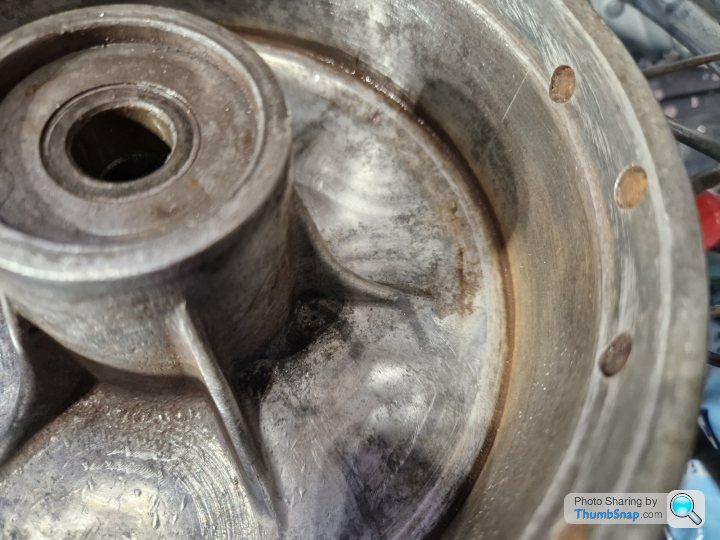
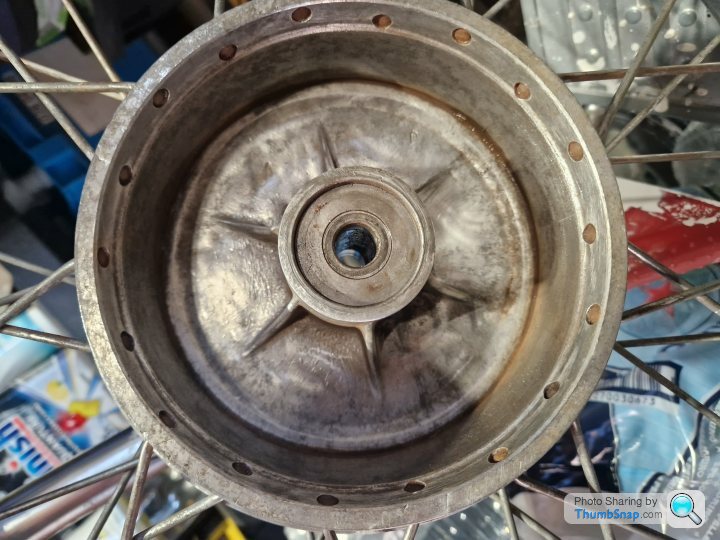
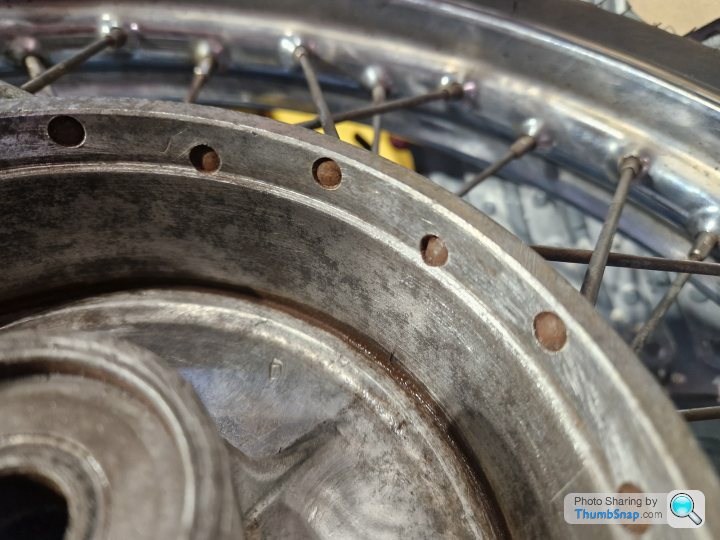
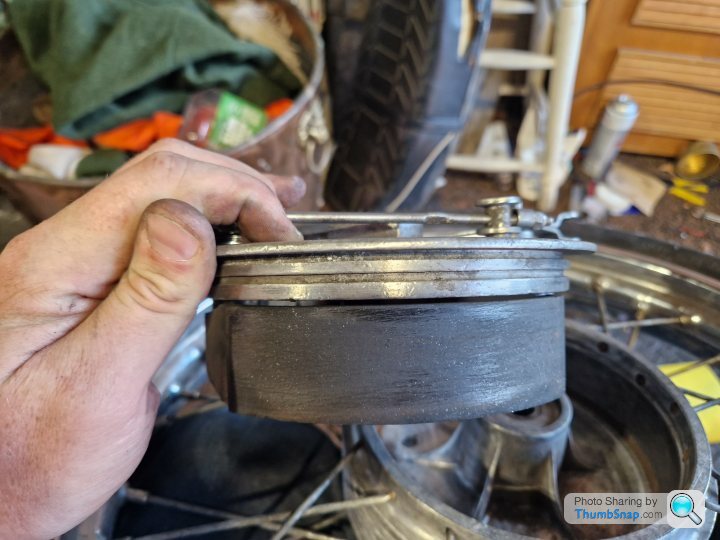
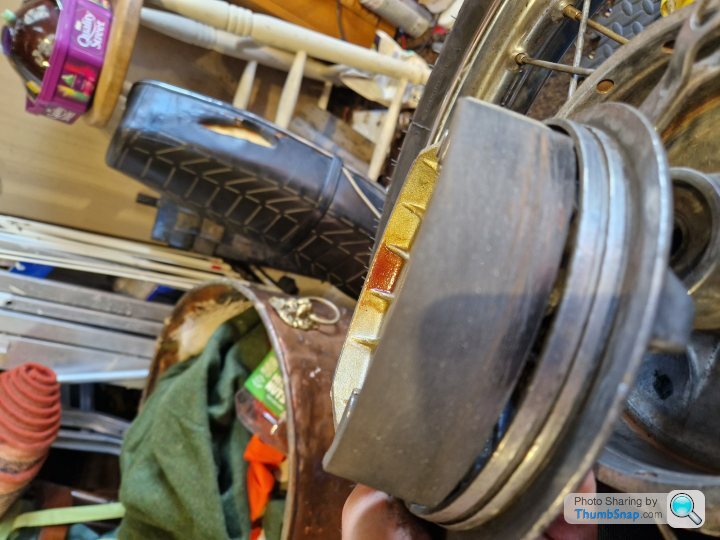
 t of a mechanic left the key in and drained the battery. I got it on it's rear wheel and span the front and occasionally grabbed the brake. It does seem better but seem to be getting an intermittent bind (not every revolution) and the brake doesn't want to release properly. I can't quite get the cable adjustment right - the cable is definitely the right one and the right length.
t of a mechanic left the key in and drained the battery. I got it on it's rear wheel and span the front and occasionally grabbed the brake. It does seem better but seem to be getting an intermittent bind (not every revolution) and the brake doesn't want to release properly. I can't quite get the cable adjustment right - the cable is definitely the right one and the right length.Only had time to adjust the rear and not take apart. It seemed far better with the adjuster wound up a fair bit more although could be better.





Biker9090 said:
Had another go yesterday evening. Cleaned the front drum out as best as I could and roughed up the (very) shiny shoes. I haven't ridden it yet as the t t of a mechanic left the key in and drained the battery. I got it on it's rear wheel and span the front and occasionally grabbed the brake. It does seem better but seem to be getting an intermittent bind (not every revolution) and the brake doesn't want to release properly. I can't quite get the cable adjustment right - the cable is definitely the right one and the right length.
t of a mechanic left the key in and drained the battery. I got it on it's rear wheel and span the front and occasionally grabbed the brake. It does seem better but seem to be getting an intermittent bind (not every revolution) and the brake doesn't want to release properly. I can't quite get the cable adjustment right - the cable is definitely the right one and the right length.
Only had time to adjust the rear and not take apart. It seemed far better with the adjuster wound up a fair bit more although could be better.
...
If the brake is not releasing cleanly, that suggests there is some friction somewhere, I would suspect the spindles of the actuating cams in the alloy backplate. t of a mechanic left the key in and drained the battery. I got it on it's rear wheel and span the front and occasionally grabbed the brake. It does seem better but seem to be getting an intermittent bind (not every revolution) and the brake doesn't want to release properly. I can't quite get the cable adjustment right - the cable is definitely the right one and the right length.
t of a mechanic left the key in and drained the battery. I got it on it's rear wheel and span the front and occasionally grabbed the brake. It does seem better but seem to be getting an intermittent bind (not every revolution) and the brake doesn't want to release properly. I can't quite get the cable adjustment right - the cable is definitely the right one and the right length.Only had time to adjust the rear and not take apart. It seemed far better with the adjuster wound up a fair bit more although could be better.
...
I'd have that apart, clean and apply the smallest amount of grease. This could be binding just as the brake starts to work. Sort that and you may have adequate brakes. If you take the shoes off the cams must move freely.
The drum looks like it's had rust in the past and been cleaned up, looks OK really. No serious wear, no ridge where the shoes don't contact.
No signs of dead wheel bearing seals greasing everything , so it could be a lot worse.
OutInTheShed said:
If the brake is not releasing cleanly, that suggests there is some friction somewhere, I would suspect the spindles of the actuating cams in the alloy backplate.
I'd have that apart, clean and apply the smallest amount of grease. This could be binding just as the brake starts to work. Sort that and you may have adequate brakes. If you take the shoes off the cams must move freely.
The drum looks like it's had rust in the past and been cleaned up, looks OK really. No serious wear, no ridge where the shoes don't contact.
No signs of dead wheel bearing seals greasing everything , so it could be a lot worse.
Thanks. Yes I'll get them apart and greased again. I used moden sealed wheel bearings rather than unsealed and bloody asbestos string lol! How does the shoe contact look? Is the duller part where they are making contact?I'd have that apart, clean and apply the smallest amount of grease. This could be binding just as the brake starts to work. Sort that and you may have adequate brakes. If you take the shoes off the cams must move freely.
The drum looks like it's had rust in the past and been cleaned up, looks OK really. No serious wear, no ridge where the shoes don't contact.
No signs of dead wheel bearing seals greasing everything , so it could be a lot worse.
Gassing Station | Biker Banter | Top of Page | What's New | My Stuff



